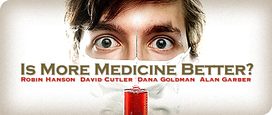Dana Goldman suggests “a catastrophic health plan, with first dollar coverage exceptions for those therapies that can be shown to be clinically efficacious and reduce total health care spending” and asks if I’d “be in favor of subsidizing this coverage for the low-income uninsured, with the subsidies paid for by eliminating the tax exclusion for health insurance premiums above the cost of this limited plan?”
Yes, relative to the status quo. But the role of health policy experts is not to say what policies we personally favor, but rather to make policy consequences clear to the public. Once we tell the public that such a policy would not much harm the health of the non-low-income, then it is up to them to decide if they want to use the savings to subsidize low-income coverage.
Dana gives an example of “what is missing from aggregate studies”: some regions could spend more to get the same health outcomes because their physicians specialize in more expensive treatments, and that if we forced those physicians to instead specialize in the cheaper (but equally effective) treatments done in other regions, “we would adversely impact patient health because the doctors in [expensive regions] aren’t as good at” cheap treatments. Well, yes, any industry must pay transition costs to switch from less to more efficient technologies, and for this transition physicians would have to retool to get good at cheaper treatments. But the fact that change is costly is not by itself a reason not to change. And this consideration is only “missing” from aggregate studies if you thought they implied zero costs of change.
Dana says “this example points out that there is much that we need to understand before we take the scalpel to health care spending.” There is always more we could understand about any policy choice, so that by itself is not a reason to delay action.

